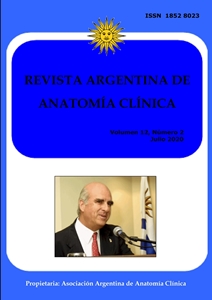Anatomical variants of the azygos system
azygos system variants
DOI:
https://doi.org/10.31051/1852.8023.v12.n2.28137Keywords:
azygos system;anatomical variants;azygos vein.Abstract
Introduction: the conformation of the azygos venous system is variable, it is formed by the azygos vein, the hemiazygos and the accessory hemiazygos. Arranged in parallel with respect to the vena cava, it is important as an alternative route for the venous return to the heart. Materials and method: 12 adult cadavers and 12 computed tomography scans of adult patients of both sexes. It was registered: type of azygos system (according to Anson classification), caliber at origin and termination of azygos and hemiazygos veins, vertebral level of completion of each one. Results: 14 (58%) female cases, 10 (42%) male cases. Type II was found in 14 (58%) cases, distributed in 9 (38%) cases of subtype 2A, 3 (12%) cases of subtype 2B, 1 (4%) case of subtype 2D, 1 (4%) case of subtype 2C. Type III was found in 9 (38%) cases. 1 (4%) type I case was found. The average caliber of the azygos vein origin was 4.2mm (2mm-7.7mm), and the hemiazygos vein was 3mm (2mm-6.9mm), The termination caliber of the azygos vein was 8.3mm (4.2mm-10.3mm), for the hemiazygos vein it was 4.9mm (3.3mm-7.2mm). The mean vertebral level of the azygos vein was T4 with 14 (58%) cases and the hemiazygos vein T8 with 8 (28.5%) cases. Conclusion: the type of azygos system is variable, and does not correlate with that described by classical authors, but with contemporary authors. There is a great correlation with different authors on the vertebral levels of termination of azygos, hemiazygos and accessory hemiazygos.
References
Alves EC, Rodrigues Porciúncula Jr W, Freitas Montes Bispo R, de Sousa-Rodrigues CF, da Rocha AC. 2011. Formation of the azygos vein. Int. J. Morphol. 29: 140-43.
Anson BJ, McVay CB. 1984. Surgical anatomy. 60th edision, Tokyo, Japón: W.B. Saunders Co. pag 464–65.
Dahran N, Soames R. 2016. Anatomical variationos of the azygos venous system: Classification and clinical relevance. Int. J. Morphol. 34:1128-36.
Kutoglu T, Turut M, Kocabiyik N, Ozan H, Yildirim M. 2012. Anatomical analysis of azygos vein system in human cadavers. Rom J MorpholEmbryol 53: 1051–56.
Laterjet M, Ruiz-Liard A. 1995. Anatomía Humana. Tomo 2. 3era edición, Madrid, España: Editorial Médica Panamericana, pag.1174-78.
LoCicero J, Feins RH, Colson YL, Rocco G. 1994. Shields' General Thoracic Surgery. Volumen 1; EstadosUnidos: Wolters Kluwer, pag. 150-60.
Piciucchi S, Barone D, Sanna S, Dubini A, Goodman LR, Oboldi D, Bertocco M, Ciccotosto C, Gavelli G, Carloni A, Poletti V. 2014. The azygos vein pathway: an overview from anatomical variations to pathological changes. InsightsImaging 5: 619–28.
Rouviere H, Delmas A. 1932. Anatomia Humana: Descriptiva, Topografica y Funcional. Tomo 2. 9na edición, Francia: Masson, S.A, pag. 235-40.
Tatar I, Denk CC, Celik HH, Oto A, Karaosmanoglu DA, Ozdemir BM, Surucu SH. 2008. Anatomy of the azygos vein examined by computerized tomography imaging.SaudiMed J 29: 1585–88.
Downloads
Published
Issue
Section
License
Copyright (c) 2020 Juan A. Cabrera Frola, Andrés Berke, María Ignatov, Gustavo Armand Ugón

This work is licensed under a Creative Commons Attribution-NonCommercial 4.0 International License.
Authors retain copyright and grant the journal right of first publication with the work simultaneously licensed under a Creative Commons Attribution License that allows others to share the work with an acknowledgement of the work's authorship and initial publication in this journal. Use restricted to non commercial purposes.
Once the manuscript has been accepted for publications, authors will sign a Copyright Transfer Agreement to let the “Asociación Argentina de Anatomía Clínica” (Argentine Association of Clinical Anatomy) to edit, publish and disseminate the contribution.



